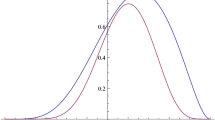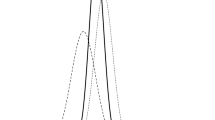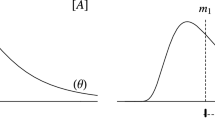Abstract
The one-sided testing problem can be naturally formulated as the comparison between two nonnested models. In an objective Bayesian setting, that is, when subjective prior information is not available, no general method exists either for deriving proper prior distributions on parameters or for computing Bayes factor and model posterior probabilities. The encompassing approach solves this difficulty by converting the problem into a nested model comparison for which standard methods can be applied to derive proper priors.
We argue that the usual way of encompassing does not have a Bayesian justification. and propose a variant of this method that provides an objective Bayesian solution. The solution proposed here is further extended to the case where nuisance parameters are present and where the hypotheses to be tested are separated by an interval. Some illustrative examples are given for regular and non-regular sampling distributions.
Similar content being viewed by others
References
Berger, J. O. andBernardo, J. M. (1992). On the development of the reference prior method. In J. M. Bernardo, J. O. Berger, A. P. Dawid, and A. F. M. Smith, eds.,Bayesian Statististics, vol. 4, pp. 35–60. Oxford University Press, Oxford.
Berger, J. O. andMortera, J. (1995). Discussion of O'Hagan.Journal of the Royal Statistical Society. Series B, 57:99–138.
Berger, J. O. andMortera, J. (1999). Default Bayes factors for nonnested hypothesis testing.Journal of the American Statistical Association, 94:542–554.
Berger, J. O. andPericchi, L. R. (1996a). The intrinsic Bayes factor for linear models. In J. M. Bernardo, J. O. Berger, A. P. Dawid, and A. F. M. Smith, eds.,Bayesian Statistic, vol. 5, pp. 23–42. Oxford University Press, Oxford.
Berger, J. O. andPericchi, L. R. (1996b). The intrinsic Bayes factor for model selection and prediction.Journal of the American Statistical Association, 91:109–122.
Berger, J. O. andPericchi, L. R. (1996c). On the justification of default and intrinsic Bayes factor. In J. C. Lee, W. Johnson, and A. Zellner, eds.,Modeling and Prediction, pp. 276–293. Springer-Verlag, New York.
Berger, J. O. andPericchi, L. R. (1997). Accurate and stable Bayesian model selection: the median intrinsic Bayes factor.Sankyà, B, 60:1–18.
Berger, J. O. andPericchi, L. R. (1998). On criticism and comparison of default Bayes factors for model selection and hypothesis testing. In W. Racugno, ed.,Proceedings of the Workshop on Model Selection, pp. 1–50. Pitagora, Bologna.
Bernardo, J. M. andSmith, A. F. M. (1994).Bayesian Theory. Wiley, New York.
Cano, J. A., Kessler, M., andMoreno, E. (2004). On intrinsic priors for nonnested models.Test, 13(2):445–463.
Casella, G. andMoreno, E. (2002a). Objective Bayesian of contingency tables. Technical report, Universidad de Granada. Submitted.
Casella, G. andMoreno, E. (2002b). Objective Bayesian variable selection. Technical report, Universidad de Granada. Submitted.
Casella, G. andMoreno, E. (2005). Intrinsic meta analysis of contingency tables.Statistics in Medicine, 24:583–604.
Cox, D. R. (1961). Test of separate families of hypothesis. In J. Neyman, ed.,Proceedings of the Fourth Berkeley Symposium on Mathematical Statistics and Probability, vol. 1, pp. 105–123. University of California Press. Berkeley.
De Santis, F. (2002). Interactive use of default and robust Bayes testing methods in the presence of vague prior information.Journal of the Royal Statistial Society. Series D, 51:451–465.
De Santis, F. andSpezzaferri, F. (1999). Methods for default and robust Bayesian model comparison: the fractional Bayes factor approach.International Statistical Review, 67:267–286.
Dmochowski, J. (1996). Intrinsic Bayes factor via Kullback-Leibler geometry. In J. M. Bernardo, J. O. Berger, A. P. Dawid, and A. F. M. Smith, eds.,Bayesian Statistics, vol. 5. Oxford University Press, London.
Huber, P. (1967). The behaviour of maximum likelihood estimators under nonstandard conditions. In L. LeCam and N. J., eds.,Proceedings of the Fifth Berkeley Symposium on Mathematical Statistics and Probability, vol. 1, pp. 221–233.
Jeffreys, H. (1961).Theory of Probability. Clarendon Press, Oxford.
Moreno, E. (1997). Bayes factor for intrinsic and fractional priors in nested models: Bayesian robustness. In D. Yadolah, ed.,L1-Statistical Procedures and Related Topics, vol. 31 ofLecture Notes-Monograph Series, pp. 257–270. Institute of Mathematical Statistics, Hayward, CA.
Moreno, E., Bertolino, F. andRacugno, W. (1998). An intrinsic limiting procedure for model selection and hypotheses testing.Journal of the American Statistical Association, 93:1451–1460.
Moreno, E., Bertolino, F., andRacugno, W. (1999). Default Bayesian analysis of the Behrens-Fisher problem.Journal of Statistical Planning and Inference, 81:323–333.
Moreno, E., Bertolino, F., andRacugno, W. (2000). Bayesian model selection approach to analysis of variance under heteroscedasticity.Journal of the Royal Statistical Society. Series D (The Statistician), 46:1–15.
Moreno, E. andLiseo, B. (2003). A default Bayesian test for the number of components of a mixture.Journal of Statistical Planning and Inference, 111:129–142.
Moreno, E., Torres, F., andCasella, G. (2005). Testing the equality of regression coefficients in heteroscedastic normal regression models.Journal of Statistical Planning and Inference, 131:117–134.
O'Hagan, A. (1995). Fractional Bayes factor for model comparison (with discussion).Journal of the Royal Statistical Society. Series B, 57:99–138.
O'Hagan, A. (1997). Properties of intrinsic and fractional Bayes factors.Test, 6:101–118.
San Martini, A. andSpezzaferri, F. (1984). A predictive model selection criterion.Journal of the Royal Statistical Society. Series B, 46:296–303.
Sansó, B., Pericchi, L. R., andMoreno, E. (1996). On the robustness of the intrinsic Bayes factor for nested models (with discussion). In J. O. Berger, B. Betró, F. Ruggeri, E. Moreno, L. Pericchi, and L. Wasserman, eds.,Bayesian Robustness, vol. 29 ofLecture Notes-Monograph Series, pp. 157–176. Institute of Mathematical Satistics, Hayward, CA.
Author information
Authors and Affiliations
Corresponding author
Additional information
This paper has been supported by Ministerio de Ciencia y Tecnología under grant BEC20001-2982
Rights and permissions
About this article
Cite this article
Moreno, E. Objective Bayesian methods for one-sided testing. Test 14, 181–198 (2005). https://doi.org/10.1007/BF02595402
Received:
Accepted:
Issue Date:
DOI: https://doi.org/10.1007/BF02595402




